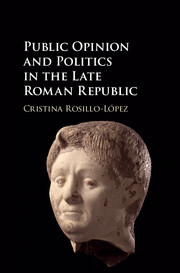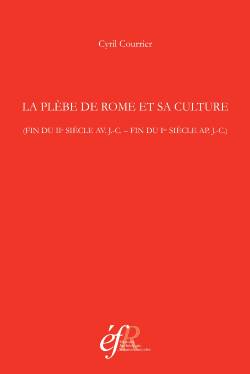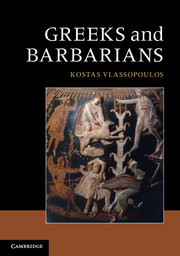Public Opinion and Politics in the Late Roman Republic
Cristina Rosillo-López
 This book investigates the working mechanisms of public opinion in Late Republican Rome as a part of informal politics. It explores the political interaction (and sometimes opposition) between the elite and the people through various means, such as rumours, gossip, political literature, popular verses and graffiti. It also proposes the existence of a public sphere in Late Republican Rome and analyses public opinion in that time as a system of control. By applying the spatial turn to politics, it becomes possible to study sociability and informal meetings where public opinion circulated. What emerges is a wider concept of the political participation of the people, not just restricted to voting or participating in the assemblies.
This book investigates the working mechanisms of public opinion in Late Republican Rome as a part of informal politics. It explores the political interaction (and sometimes opposition) between the elite and the people through various means, such as rumours, gossip, political literature, popular verses and graffiti. It also proposes the existence of a public sphere in Late Republican Rome and analyses public opinion in that time as a system of control. By applying the spatial turn to politics, it becomes possible to study sociability and informal meetings where public opinion circulated. What emerges is a wider concept of the political participation of the people, not just restricted to voting or participating in the assemblies.Popular Culture in the Ancient World
Lucy Grig (ed.)
Contributors: Lucy Grig, Mirko Canevaro, James Robson, Cristina Rosillo-López, Cyril Courrier, Tom Hawkins, Alexandre Vincent, Jerry Toner, Victoria Jennings, April Pudsey, Nicola Denzey Lewis, Jaclyn Maxwell, Julio Cesar Magalhães de Oliveira.
Popular Culture in the Ancient World is the first book to provide an interdisciplinary study of the subject. Traditionally neglected by classical scholars, popular culture provides a new window through which we can view the ancient world. An international group of scholars tackles a fascinating range of subjects and objects – from dice oracles to dressing up, from toys to theological speculation. Diverse comparative and theoretical approaches are used alongside many different ancient sources to provide a wide-ranging and rigorous approach to ancient popular culture. After a substantive introduction, the book moves from classical Greece through the Roman Empire to end in the late antique world. It enriches our understanding of the ancient world as well as our conception of the legacy of the ancient world in our own.
Theodotus of Ancyra's Homilies and the Council of Ephesus (431)
Luise Marion Frenkel
 "To complement the ongoing run of books published on the better known ecclesiastical figures from the eastern empire in Late Antiquity–the Gregorys, Basil the Great, even these days Cyril of Alexandria–it is both refreshing and instructive to take a look at well-worn narratives and familiar events from the perspective of a lesser known participant. Frenkel’s published version of her Cambridge doctoral thesis, written under the supervision of Thomas Graumann, is neither a biography of its protagonist, nor simply a retelling of the story of the council of Ephesus, nor is it a literary study of the homily-genre; rather it draws something from all of these types of study. [...] The present work adds something new since, by focusing on the homilies of a marginal character, she has highlighted the ways in which both popular and episcopal support was incited on behalf of a church-political party, as well as the means by which a bishop such as Theodotus could fashion his self-image before of his peers. The works by and about the major figures are too tainted by their big agendas, and do not lend themselves to understanding these events from the perspective of a ‘regular’ participant, and this is just the sort of ‘history from below’ that Frenkel hopes to have provided." (Daniel King)
"To complement the ongoing run of books published on the better known ecclesiastical figures from the eastern empire in Late Antiquity–the Gregorys, Basil the Great, even these days Cyril of Alexandria–it is both refreshing and instructive to take a look at well-worn narratives and familiar events from the perspective of a lesser known participant. Frenkel’s published version of her Cambridge doctoral thesis, written under the supervision of Thomas Graumann, is neither a biography of its protagonist, nor simply a retelling of the story of the council of Ephesus, nor is it a literary study of the homily-genre; rather it draws something from all of these types of study. [...] The present work adds something new since, by focusing on the homilies of a marginal character, she has highlighted the ways in which both popular and episcopal support was incited on behalf of a church-political party, as well as the means by which a bishop such as Theodotus could fashion his self-image before of his peers. The works by and about the major figures are too tainted by their big agendas, and do not lend themselves to understanding these events from the perspective of a ‘regular’ participant, and this is just the sort of ‘history from below’ that Frenkel hopes to have provided." (Daniel King)La plèbe de Rome et sa culture (fin du IIe siècle av. J.-C. - fin du Ier siècle ap. J.-C.)
Cyril Courrier
 This book aims at reconstructing the composition, the role and the imaginary of the urban plebs in Rome from the Gracchi to Domitian, reformulating its history from the new angle made available by sociological tools, in particular the concept of culture and the postulate in which a dominant social group is rarely able to impose its cultural order thoroughly. Cyril Courrier brings to the fore the existence of a world peculiar to the plebeians, of which we can perceive tangible traces in fields as diverse as how the plebeians positioned themselves in their trade, in the urban space, or in politics; all this can be gathered together as a system, whose coherence is put under close scrutiny : was there a combination of behaviours which might have enabled the plebeians to view themselves as a world in itself? We must seek an answer in the demographic stability and sociospatial unity Rome conferred to the plebeians, who thought of themselves as the people of an imperial capital in which living conditions were not that of the “Urban Graveyard Effect”. They were not a Lumpenproletariat, pricking up their ears for rumours of a riot, but a stable element of the Roman society whose strata were deeply rooted in the urban space, middle sections whose possessions enabled their members to be acknowledged in the city and its institutions and have an influence on political trends. Indeed, the plebeians were politically conscious, and they knew how to get the attention of those in power. The plebeians did not the more form a monolithic entity, but were divided into subgroups which, like the plebs media, structured them into as many membership systems, both horizontal and vertical.
This book aims at reconstructing the composition, the role and the imaginary of the urban plebs in Rome from the Gracchi to Domitian, reformulating its history from the new angle made available by sociological tools, in particular the concept of culture and the postulate in which a dominant social group is rarely able to impose its cultural order thoroughly. Cyril Courrier brings to the fore the existence of a world peculiar to the plebeians, of which we can perceive tangible traces in fields as diverse as how the plebeians positioned themselves in their trade, in the urban space, or in politics; all this can be gathered together as a system, whose coherence is put under close scrutiny : was there a combination of behaviours which might have enabled the plebeians to view themselves as a world in itself? We must seek an answer in the demographic stability and sociospatial unity Rome conferred to the plebeians, who thought of themselves as the people of an imperial capital in which living conditions were not that of the “Urban Graveyard Effect”. They were not a Lumpenproletariat, pricking up their ears for rumours of a riot, but a stable element of the Roman society whose strata were deeply rooted in the urban space, middle sections whose possessions enabled their members to be acknowledged in the city and its institutions and have an influence on political trends. Indeed, the plebeians were politically conscious, and they knew how to get the attention of those in power. The plebeians did not the more form a monolithic entity, but were divided into subgroups which, like the plebs media, structured them into as many membership systems, both horizontal and vertical.Potestas Populi: Participation populaire et action collective dans les villes de l'Afrique romaine tardive (vers 300-430 apr. J.-C.)
Julio Cesar Magalhães de Oliveira
Compared to the scholarly interest on popular politics in Classical Greece or Republican Rome, the study of the urban plebs of the Later Roman Empire has been remarkably neglected, despite the recurrent discussions about urban violence in the period. This book is an attempt to reverse this situation for the particular context of the North African provinces, from the beginning of the fourth century to the Vandal conquest. Its main objective is to understand the forms and conditions of popular participation and collective action in the cities of North Africa, by placing them in the broader context of economic activities, social relations, and cultural traditions of the plebs. In order to explore the logic inherent in each crowd action, the author analyses a number of episodes of popular intervention revealed by 4th- and 5th-centuries ecclesiastical sources, and particularly by the sermons and letters of Saint Augustine. These case studies are preceded by a more general analysis of the textual and archaeological evidence on the formative experiences of the plebeian life: work, dwelling conditions, and networks of sociability. This wider context is intended to furnish a better understanding of the bases on which the members of the urban plebs could establish relations of group solidarity and cultivate a political culture that prescribed and legitimized their forms of collective action.
Greeks and Barbarians
Kostas Vlassopoulos
This book is an ambitious synthesis of the social, economic, political and cultural interactions between Greeks and non-Greeks in the Mediterranean world during the Archaic, Classical and Hellenistic periods. Instead of traditional and static distinctions between Greeks and Others, Professor Vlassopoulos explores the diversity of interactions between Greeks and non-Greeks in four parallel but interconnected worlds: the world of networks, the world of apoikiai ('colonies'), the Panhellenic world and the world of empires. These diverse interactions set into motion processes of globalisation; but the emergence of a shared material and cultural koine across the Mediterranean was accompanied by the diverse ways in which Greek and non-Greek cultures adopted and adapted elements of this global koine. The book explores the paradoxical role of Greek culture in the processes of ancient globalisation, as well as the peculiar way in which Greek culture was shaped by its interaction with non-Greek cultures.
A Democracia Ateniense pelo Avesso: Os Metecos e a Política nos Discursos de Lísias
Fábio Augusto Morales
 Fabio Morales analyses in this book the question of foreign residents in late fifth- and early fourth-century BC Athens by focusing on the speeches of Lysias, a metic resident who defended the Athenian democracy even not being a citizen. His main aim is to rethink the exclusion and politics in the Athenian polis trough a metic point of view, by analysing the Corpus Lysiacum, a series of speeches attributed to Lysias preserved over the centuries. For Maria Beatriz Borba Florenzano, the author demonstrates in this book the "possible places of the politics", where metics could act, influence decisions and choose paths to the city they shared with the citizens. By exploring the subtleties of Lysias’ speeches, the author explains the contradictions that give so much spice to one of the largest cities of the ancient Greek world.
Fabio Morales analyses in this book the question of foreign residents in late fifth- and early fourth-century BC Athens by focusing on the speeches of Lysias, a metic resident who defended the Athenian democracy even not being a citizen. His main aim is to rethink the exclusion and politics in the Athenian polis trough a metic point of view, by analysing the Corpus Lysiacum, a series of speeches attributed to Lysias preserved over the centuries. For Maria Beatriz Borba Florenzano, the author demonstrates in this book the "possible places of the politics", where metics could act, influence decisions and choose paths to the city they shared with the citizens. By exploring the subtleties of Lysias’ speeches, the author explains the contradictions that give so much spice to one of the largest cities of the ancient Greek world.Libertate opus est: Escravidão, manumissão e cidadania à época de Nero (54-68 d.C.)
Fábio Duarte Joly
This work is a study about slavery during the Principate of Nero (AD 54-68), focusing upon the connections between politics and master-slave relationships in imperial Rome. The Early Roman Empire is not thus considered as a static period, but characterized by political tensions concerning the social position of slaves and freedmen. From a structural point of view, the work is divided in two main parts: 1) exposition and critique of the concept of slave society as applied to the Roman Empire, 2) analysis of the contemporary and later literary sources relating to the Principate of Nero. The ultimate objective is to point out the circumscription of a concept of slave society to the city of Rome as well as highlight manumission as its main component.
Gladiadores na Roma Antiga
Renata Senna Garraffoni
 In the last decades, the studies of the Roman arena and gladiators’ fights have been changing. Many researchers are discussing traditional points of view, such as the idea of panem et circences, Romanization and the Roman bloodthirst, and they are also looking for other possibilities to understand these singular phenomena. According to this recent discussions, Renata Senna Garraffoni explores two interrelated topics. First, she discusses the different images of Roman arena and gladiators that were produced by modern historians. Second, she draws on written texts and material sources, such as the amphitheatres, graphite’s inscriptions and tombstones, to study the daily life of the gladiators and the popular strata that appreciated the Roman munera, which happened during the first century A. D.
In the last decades, the studies of the Roman arena and gladiators’ fights have been changing. Many researchers are discussing traditional points of view, such as the idea of panem et circences, Romanization and the Roman bloodthirst, and they are also looking for other possibilities to understand these singular phenomena. According to this recent discussions, Renata Senna Garraffoni explores two interrelated topics. First, she discusses the different images of Roman arena and gladiators that were produced by modern historians. Second, she draws on written texts and material sources, such as the amphitheatres, graphite’s inscriptions and tombstones, to study the daily life of the gladiators and the popular strata that appreciated the Roman munera, which happened during the first century A. D.



